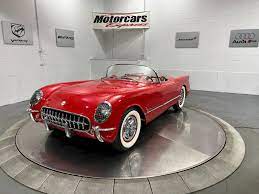On January 16, 1953, the automotive world witnessed the birth of an American icon—the Chevrolet Corvette. Introduced as a concept car at the General Motors Motorama exhibition in New York City, the Corvette captured the imagination of car enthusiasts with its sleek design and sporty appeal. Little did anyone know that this day would mark the beginning of a legacy that continues to thrive more than half a century later. The 1953 Chevrolet Corvette was the brainchild of Harley J. Earl, GM's pioneering Vice President of Design, who aimed to create a two-seater sports car that would showcase cutting-edge design and engineering. The Corvette was named after a small and fast naval escort ship, reflecting the speed and agility intended for the new automobile. The first production Corvette was unveiled at the Waldorf-Astoria Hotel in New York City, making its public debut at the Motorama show. Its stunning Polo White exterior and Sportsman Red interior immediately set it apart from other cars of its time. The Corvette featured a fiberglass body, a revolutionary choice that contributed to its lightweight and agile performance. Under the hood, the 1953 Corvette was powered by a Blue Flame inline-six engine paired with a two-speed Powerglide automatic transmission. The initial performance might not have been as breathtaking as its appearance, but the Corvette's design and concept laid the groundwork for the iconic sports car brand that would evolve over the years. Only 300 units of the 1953 Corvette were produced, making it a rare and sought-after collector's item today. Despite its limited production, the debut Corvette left an indelible mark on automotive history, setting the stage for subsequent generations of this beloved American sports car. The 1953 Corvette faced challenges in its early years, with criticisms directed at its performance and the limited color options. However, Chevrolet remained committed to refining and perfecting the Corvette, addressing concerns and steadily enhancing its capabilities. As the years progressed, the Corvette evolved into a symbol of American automotive excellence. Each generation brought innovations in design, performance, and technology. The Corvette became a fixture on racetracks, earning accolades and victories in various competitions. Notable models, such as the Stingray and ZR1, further solidified the Corvette's reputation as a high-performance sports car. Beyond its performance prowess, the Corvette became a cultural icon, featured in movies, music, and literature. Its distinctive design and powerful presence made it a symbol of freedom and the open road, capturing the imaginations of car enthusiasts worldwide. The 1953 Corvette remains a highly coveted collector's item, a testament to its historical significance and the beginning of a remarkable automotive journey. Over the decades, the Corvette has become a showcase for technological innovation and design excellence, embodying the spirit of American ingenuity on wheels. January 16, 1953, stands as a milestone in automotive history—a day that witnessed the birth of a legend, the Chevrolet Corvette.
16 January 1953 Corvette
